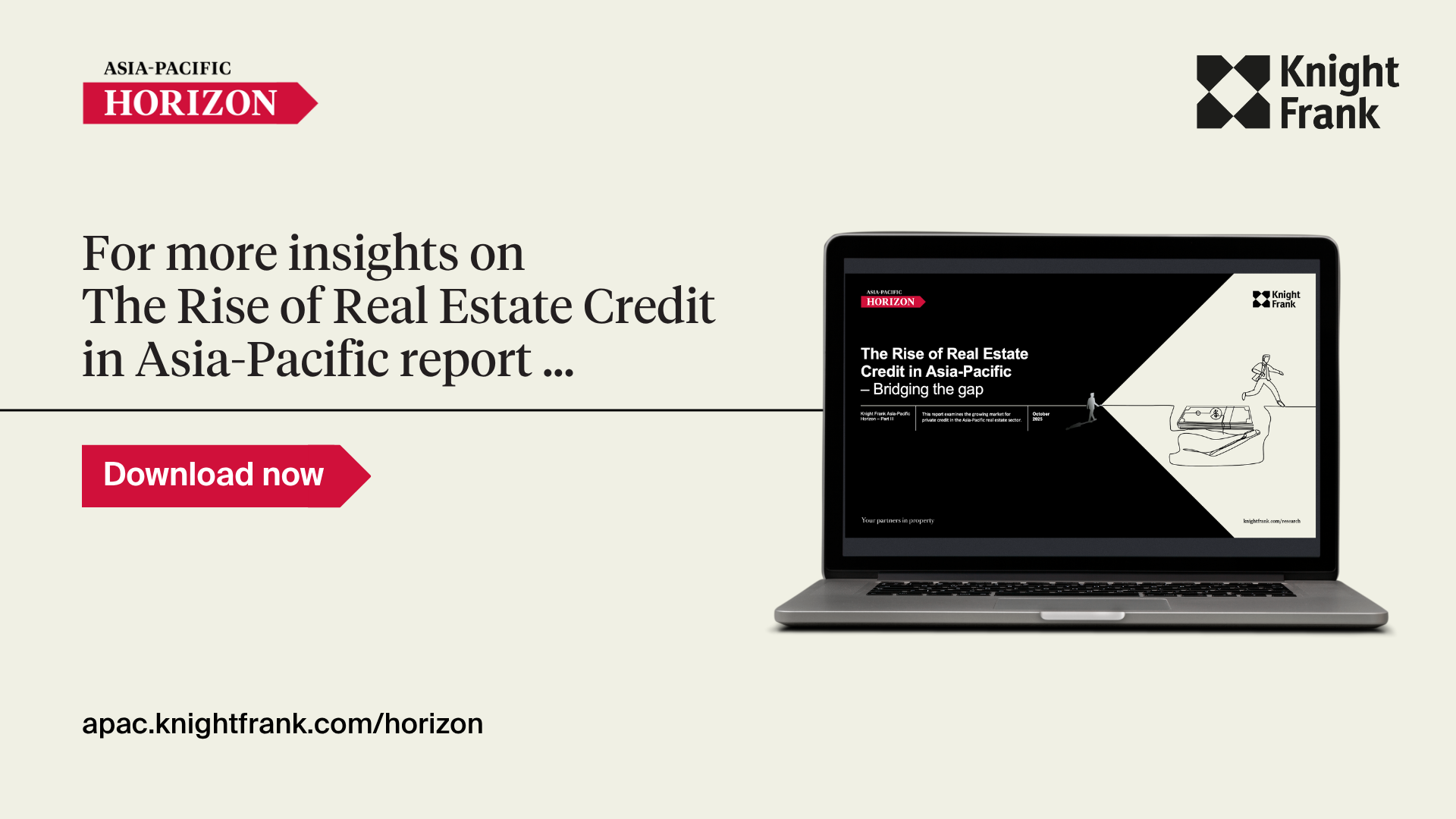Private credit, or non-bank financing for institutional and private clients, has rapidly emerged as one of the fastest-growing segments in Asia-Pacific capital markets, although from a relatively low base.
In real estate, this shift is providing borrowers with a credible and competitive alternative to traditional bank financing.
The broader trend is evident globally. In the first half of 2025, private credit fundraising directed toward the real estate sector reached 19% of total private credit fundraising. This is the highest share in the past five years, reflecting investor confidence in real estate as an asset class and the growing role of private credit in meeting financing needs.
A different path from the West
Despite this global momentum, Asia-Pacific remains under-penetrated compared with Western markets. As of June 2025, the region accounted for only 5% of global private credit, based on target fundraise amounts, well behind North America (44%) and Europe (29%).
This gap stems from fundamental structural differences. Most developed Asia-Pacific economies—Singapore, Australia, and Japan—are net savers with ample bank deposits and low loan-to-deposit ratios. Banks in these markets actively seek lending opportunities, unlike their counterparts in the United States and Europe, where deposit shortfalls and higher regulatory capital costs push institutions to offload real estate exposures to the private market.
Around 94% of lending in the region is conducted through banks, compared with 79% in Europe and only 38% in the US. This dominance reflects both the depth of domestic banking systems and the comparatively less developed state of public capital markets across Asia-Pacific.
Many Asian markets also remain heavily relationship-driven, with borrowers preferring their long-standing banking partners for bespoke solutions rather than diversifying across multiple lenders as is common in Europe.
Where private credit fits
Rather than displacing banks, private credit in Asia-Pacific plays a complementary and cyclical role. Banks remain competitive providers of straightforward real estate loans, while private credit fills targeted gaps: higher-risk developments, refinancing under stress, cross-border transactions, or situations requiring additional leverage.
Many private credit funds in the region rely on bank financing to enhance returns, highlighting how closely the two systems remain intertwined.
The strategies employed span the risk spectrum.
Senior loans provide the most conservative exposure with first-lien security, while mezzanine debt sits between senior debt and equity, offering higher yields for subordinated positions. Stretched senior loans push loan-to-value ratios beyond traditional bank comfort levels, and whole loans combine senior and junior tranches in single transactions. For more aggressive investors, rescue capital and special situations financing target distressed assets and complex restructurings.
Four key drivers
Institutional appetite grows
Institutional capital is flowing into Asia-Pacific real estate private credit at an accelerating pace. Fundraising reached US$11.2 billion between 2020 and 2024, a 40% jump from the prior five years. Average fund sizes have consistently exceeded US$100 million since 2022, reflecting both stronger capital commitments and the rising funding requirements of real estate projects.
Australia leads regional activity, capturing 40% of the US$11.2 billion raised between 2020 and 2024. Private credit now accounts for an estimated US$50 billion or 16% of total commercial real estate lending in the country.
India follows with 36% of regional fundraising, driven by rapid scale-up and regulatory reforms. The country's private-credit assets under management have grown to US$17.8 billion in 2023 from just US$0.7 billion in 2010.
South Korea accounts for 11% of the regional total, while Japan represents 5%, with the remaining 8% spread across other markets.
Family offices step in
With global family office assets estimated at US$3.1 trillion, appetite for private credit is rising as traditional private equity distributions slow. Family offices typically embrace a buy-and-hold approach, making them comfortable with illiquid assets like private credit. Volatility in public markets further enhances the appeal of privately held investments.
In Asia-Pacific, where family offices prioritise capital preservation, intergenerational wealth planning, and balanced portfolio construction, private credit offers a stabilising, yield-oriented option suited to regional investment approaches.
Bank regulations create opportunities
Basel III requirements force large Asia-Pacific banks to hold more equity capital when lending to real estate. These loans are large, long-dated, and consume significant regulatory capital when kept on balance sheets. Basel IV adds further pressure, with particularly heavy capital charges for real estate bonds under trading books.
This regulatory environment pushes banks toward standardised, lower-risk weighted loans and away from private-credit-like risk profiles. Non-bank lenders step into this gap with more flexible financing structures.
Market conditions favour alternatives
The current environment of elevated interest rates and selective bank lending has created specific opportunities. Borrowers seeking refinancing, needing faster execution, or requiring more flexible terms increasingly turn to private credit when traditional channels prove too slow or restrictive.
Looking ahead
Knight Frank projects a total growth opportunity of US$90 to- US$110 billion for private credit across Australia, Hong Kong SAR, India, and South Korea over the next three years, largely driven by Australia (almost 50%) and India (20-25%). The projection factors in overall real estate debt growth and the expected expansion of private credit market share through 2028.
This growth trajectory will be more nuanced than in Western markets. The opportunities for private credit in Asia-Pacific are expected to remain selective, arising from cyclical dislocations, market stress, or specific borrower needs for flexible capital rather than wholesale displacement of traditional banking relationships.
US investors remain largely domestically focused, but European interest in Asia-Pacific private credit is expected to rise as market conditions stabilise.
For investors, the appeal lies in consistent yield generation, portfolio diversification, and access to a growing but still under-penetrated market. For borrowers, private credit offers speed, flexibility, and certainty of execution when traditional channels fall short.
As the region's funding landscape continues to evolve, private credit is positioning itself not as a replacement for banks, but as an increasingly important component of a more diverse real estate financing system.
For more insights, please download the latest edition of Knight Frank’s Asia-Pacific Outlook series, The Rise of Real Estate Credit in Asia-Pacific - Bridging the Gap, report below.

For further information, please contact: Ahfisah Rahman, Content and PR Director, Asia-Pacific
Notes to Editors
Knight Frank LLP is the leading independent global property consultancy. Headquartered in London, the Knight Frank network has 740+ offices across more than territories and more than 27,000 people. The Group advises clients ranging from individual owners and buyers to major developers, investors, and corporate tenants. For further information about the Firm, please visit www.knightfrank.com.





